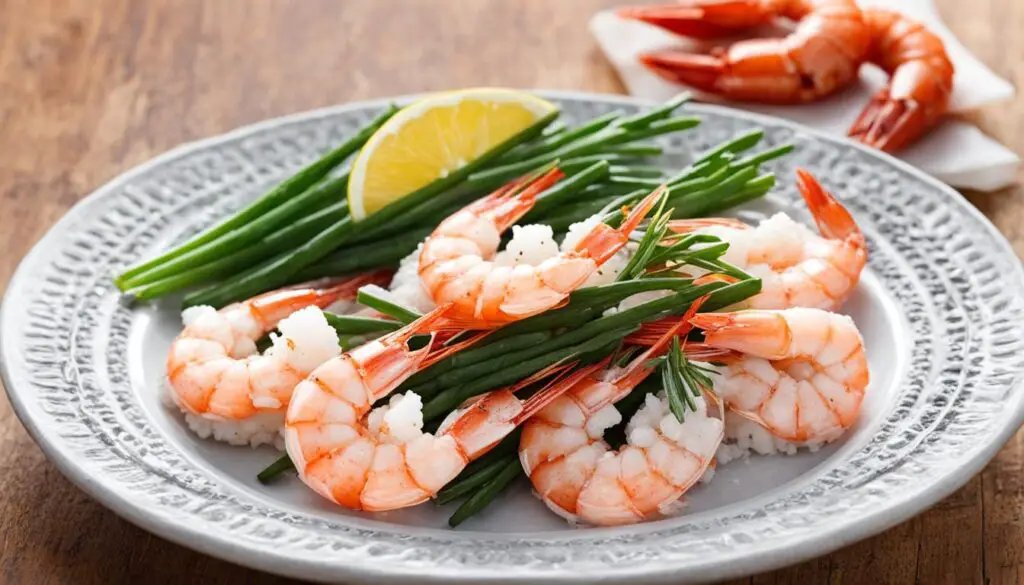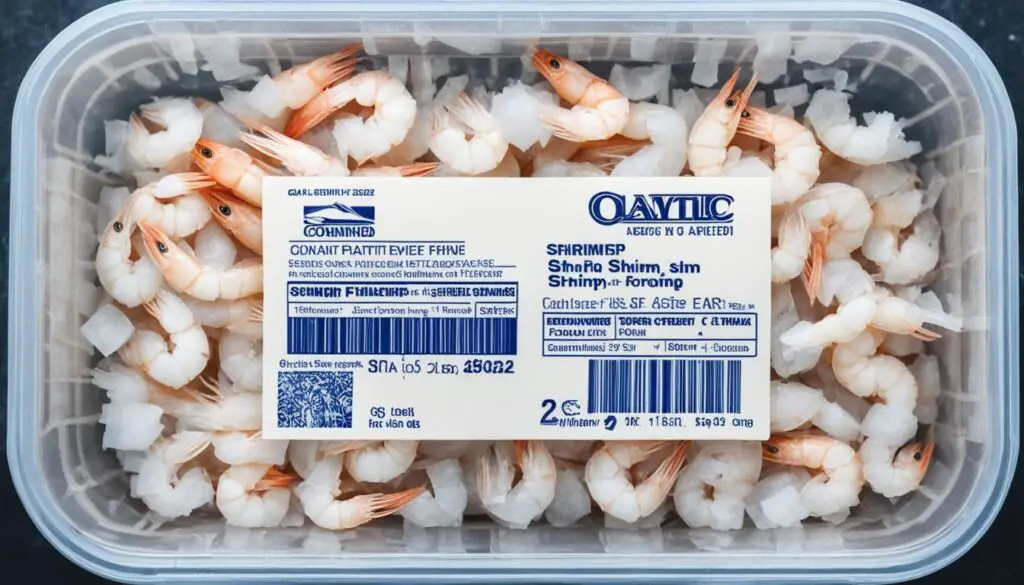If you find yourself with thawed shrimp that you won’t be able to consume immediately, you may be wondering if it’s safe to refreeze them. In this article, we will explore the topic of refreezing shrimp and provide you with valuable storage tips to maintain the quality of your seafood.
It’s important to note that while shrimp can be refrozen after thawing, it’s best to avoid doing so if possible. Each freeze-thaw cycle can impact the taste and texture of the shrimp, potentially leading to a less enjoyable eating experience. However, if you find yourself in a situation where you need to refreeze shrimp, there are guidelines you can follow to minimize any negative effects.
Key Takeaways:
- Refreezing shrimp is possible but can affect the taste and texture.
- If you need to refreeze shrimp, do so in smaller portions.
- Thaw shrimp properly in the refrigerator before refreezing.
- Raw shrimp generally refreezes better than cooked shrimp.
- Store shrimp in airtight containers to avoid freezer burn.
Can You Refreeze Raw Shrimp?
Yes, you can refreeze raw shrimp if done properly. It is best to refreeze raw shrimp that hasn’t been cooked, as this minimizes the impact on taste and texture. When refreezing raw shrimp, it is important to ensure it has been defrosted for no more than two days and that it is in good condition with no off smells or discoloration. It is also recommended to freeze raw shrimp in smaller portions for easier thawing and to maintain quality.
By following these shrimp freezing guidelines, you can safely refreeze raw shrimp without compromising its quality or flavor. Here are the key steps to refreeze raw shrimp:
- Ensure the raw shrimp has not been previously cooked.
- Thaw the shrimp in the refrigerator for no more than two days.
- Check for any signs of spoilage, such as off smells or discoloration.
- If the shrimp passes the inspection, divide it into smaller portions for easier thawing and to prevent the need for refreezing.
- Place each portion of raw shrimp in airtight freezer bags or containers to protect them from freezer burn.
- Label the bags or containers with the date to keep track of their freshness.
- Store the shrimp in the freezer at a temperature of 0°F (-18°C) or below.
Following these guidelines will help you maintain the quality of raw shrimp when refreezing it. By freezing raw shrimp in smaller portions and properly storing it, you can keep it fresh for future use.
Remember, always thaw frozen shrimp in the refrigerator to ensure safe consumption. Refreezing raw shrimp should be done sparingly to preserve its taste and texture. It is generally best to use thawed shrimp promptly to enjoy its optimal quality.
| Factors | Raw Shrimp | Cooked Shrimp |
|---|---|---|
| Taste and Texture | Minimal impact on taste and texture | The cooking process may affect taste and texture when refreezing |
| Thawing and Quality | Thaw raw shrimp in the refrigerator for no more than two days. Check for spoilage. Freeze in smaller portions for easier thawing. | Cool cooked shrimp fully before refreezing. Thaw in the refrigerator or cold water to prevent bacterial growth. |
| Long-Term Storage | Store raw shrimp in airtight freezer bags or containers to prevent freezer burn. | Properly store cooked shrimp in airtight containers to avoid moisture absorption and maintain quality. |
Can You Refreeze Cooked Shrimp?
Yes, you can refreeze cooked shrimp, but it’s important to follow a few guidelines to ensure safety and maintain the quality of the shrimp. Here’s what you need to know:
1. Proper Cooling:
Before refreezing cooked shrimp, it is crucial to let it fully cool down. This helps reduce the risk of freezer burn and ensures that the shrimp stays fresh during storage.
2. Considerations for Previously Frozen Shrimp:
Cooked shrimp that has been previously frozen may not refreeze as well as raw shrimp. The cooking process can further impact the taste and texture, making them slightly different from their original state. However, if handled properly, the refrozen cooked shrimp should still be safe to consume.
3. Thawing Cooked Shrimp:
When it comes to thawing cooked shrimp, it’s important to do so in a way that minimizes the risk of bacterial growth. The best methods for thawing cooked shrimp are:
- Thawing in the refrigerator: Place the frozen cooked shrimp in a container and let it thaw slowly in the refrigerator overnight. This ensures a gradual thawing process and maintains the quality of the shrimp.
- Thawing in cold water: If you need to thaw the shrimp more quickly, you can place it in a sealed plastic bag and submerge it in cold water. Make sure to change the water every 30 minutes to ensure that it remains cold.
It’s important to never thaw cooked shrimp at room temperature, as this can promote the growth of harmful bacteria.
To understand the process better, here’s a summary:
Can I refreeze cooked shrimp? Absolutely! After fully cooling the cooked shrimp, you can safely refreeze it. When it comes time to thaw, be sure to use the refrigerator or cold water methods to maintain proper food safety. Avoid thawing at room temperature to prevent bacterial growth.
In the next section, we will explore best practices for freezing shrimp to ensure optimal results. But before that, take a moment to visualize the process with this helpful diagram:

|
Best Practices for Freezing Shrimp
To ensure the best quality when freezing shrimp, it is recommended to follow these best practices:
- Refreeze shrimp as soon as possible after thawing: Ideally, shrimp should be refrozen within two days of thawing to maintain its freshness and flavor.
- Freeze shrimp in smaller portions: Whenever possible, freeze shrimp in smaller portions. This helps avoid the need for refreezing and allows for easier thawing when needed.
- Raw shrimp generally refreezes better than cooked shrimp: If given the choice, it is preferable to refreeze raw shrimp rather than cooked shrimp. Raw shrimp tends to retain its texture and flavor better during the freezing and thawing process.
- Always thaw shrimp in the refrigerator: Thawing shrimp in the refrigerator is the best method to preserve its taste and texture. This slow and gentle thawing process helps maintain the quality of the shrimp.
- Properly store shrimp in airtight freezer bags or containers: It is essential to store shrimp in airtight freezer bags or containers to prevent freezer burn. This ensures that the shrimp retains its freshness and quality during storage.
By following these shrimp storage tips and freezing guidelines, you can maintain the best possible quality of your shrimp, whether fresh or previously thawed. Remember to thaw shrimp in the refrigerator and store it properly to avoid any negative effects on taste and texture.
Comparison of Proper Shrimp Storage Practices
| Storage Practice | Benefits |
|---|---|
| Refreeze shrimp as soon as possible after thawing | – Maintains freshness – Minimizes moisture loss – Preserves flavor |
| Freeze shrimp in smaller portions | – Reduces the need for refreezing – Easier portion control – Faster thawing |
| Raw shrimp generally refreezes better than cooked shrimp | – Retains texture and flavor better – Less impact on taste and quality |
| Always thaw shrimp in the refrigerator | – Preserves taste and texture – Prevents bacterial growth |
| Properly store shrimp in airtight freezer bags or containers | – Prevents freezer burn – Maintains freshness and quality – Extends shelf life |

Conclusion
In conclusion, can shrimp be refrozen after thawing? While it is possible to refreeze shrimp after it has been thawed, it is generally recommended to avoid doing so if possible. This is because each freeze-thaw cycle can have an impact on the taste and texture of the shrimp. To maintain the best quality, it is advisable to only refreeze shrimp if absolutely necessary.
When it comes to refreezing shrimp, it is important to note that raw shrimp generally refreezes better than cooked shrimp. Raw shrimp that hasn’t been cooked yet will have less of a noticeable impact on its taste and texture. However, if you do need to refreeze cooked shrimp, make sure to fully cool it down before placing it in the freezer to minimize the risk of freezer burn.
Proper thawing and storage techniques play a crucial role in maintaining the quality of refrozen shrimp. Thaw shrimp in the refrigerator rather than at room temperature to prevent bacterial growth. If you choose to refreeze shrimp, do so as soon as possible within two days of thawing and store it in airtight freezer bags or containers to prevent freezer burn.
By following these shrimp storage guidelines, you can safely refreeze shrimp and minimize any undesirable effects on taste and texture. While it’s best to consume shrimp fresh or properly defrost it before cooking, understanding how to safely refreeze shrimp can be helpful in preventing food waste and ensuring you can enjoy this delicious seafood at a later time.
FAQ
Can shrimp be refrozen after thawing?
Yes, shrimp can be refrozen after thawing, but there are several factors to consider. Each freeze-thaw cycle can affect the taste and texture of the shrimp, so it is best to avoid refreezing if possible.
Can you refreeze raw shrimp?
Yes, you can refreeze raw shrimp if it has been defrosted for no more than two days and is in good condition. It is recommended to freeze raw shrimp in smaller portions for easier thawing and to maintain quality.
Can you refreeze cooked shrimp?
Yes, you can refreeze cooked shrimp, but it should be fully cooled before freezing to reduce the chance of freezer burn. Thaw cooked shrimp in the refrigerator or cold water and avoid thawing at room temperature to prevent bacterial growth.
What are the best practices for freezing shrimp?
To properly freeze shrimp, it is recommended to refreeze them as soon as possible after thawing, ideally within two days. Freeze shrimp in smaller portions if possible and thaw them in the refrigerator for safe refreezing. Store shrimp in airtight freezer bags or containers to prevent freezer burn and maintain quality.

